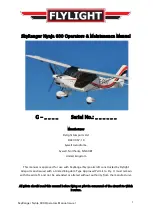
12
FLYING THE PASHA 4
The following information must not under any circumstances be taken as a
manual for practising paragliding. We would like to advise you of the Pasha 4's
features and important information for your flying and security.
Preparing for take off:
As with any aircraft, a thorough pre-flight check must be made prior to each flight on the
Pasha 4!
Before every launch check lines, risers and canopy for damage! Do not launch with
even the slightest damage!
Also check the maillons connecting the lines and the risers. They have to be closed
tight.
Put on the harnesses and spreader-bars with maximum care and check the handle of
the safety system and that all the flaps of the outer container are fastened securely and
correctly. The main karabiners must also be checked carefully. Replace it if any damage
is visible, or generally after 300 flying hours. Connect harnesses with the spreader-bars
and finally connect the risers to your spreader-bars with the main karabiners. Check
carefully that they are properly closed.
Attention! Never fly with an open main karabiner! Do not take off if you find any
damage to your equipment!
Having unpacked and laid out the paraglider in a slight horseshoe pattern the following
checks must be made:
Checklist:
Preparing the wing:
•
canopy
without
any
damage
•
risers and spreader-bars without any damage
•
maillons (quick links) closed tight
•
stitching of the main lines near the risers is o.k.
•
all main lines run free from the riser to the canopy, brake lines are free
Putting on the harness:
•
rescue handle and deployment pins secure
•
buckles (leg and chest strap) closed
•
main
karabiners
Before takeoff:
•
spreader-bars mounted and connected properly
•
risers not twisted
•
brake handle in hands, brake lines free
•
pilot's position relative to the wing (centred: all lines same tension)
•
wind
direction
•
obstacles on the ground
•
free
airspace
Summary of Contents for Pasha 4
Page 1: ......
Page 25: ...25 Line plan Pasha 4 39 ...
Page 26: ...26 Line plan Pasha 4 42 ...
Page 30: ...30 CHECKS Name Company Date Signature Stamp ...
Page 32: ...32 ...













































